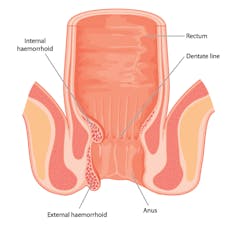 Almost half of all people will experience haemorrhoids at some point.from shutterstock.com
Almost half of all people will experience haemorrhoids at some point.from shutterstock.comYou may think of piles as those dreaded things your mum said you’d get if you kept sitting on cold concrete. But actually, every healthy person has piles, or haemorrhoids.
They are columns of cushioned tissue and blood vessels found close to the opening of the anus. And they help you maintain bowel continence or, to put it simply, keep your poo in.
Haemorrhoids can be either external (when they grow very close to the anus opening) or internal (when they grow further away in the anus).
Internal haemorrhoids (which we all have) can become a problem when they are swollen or inflamed.
External haemorrhoids are covered by a rich supply of pain fibres and are more likely to be associated with pain. External haemorrhoids can develop clots due to blood in them becoming stagnant and from trauma to blood vessels from straining. This can make them tender and swollen.
The exact cause of haemorrhoids isn’t entirely clear. But they are certainly common; around 50% of people have experienced symptomatic haemorrhoids at some point in their lives.
Who is most likely to get them?
 Haemorrhoids can be internal or external.from shutterstock.com
Haemorrhoids can be internal or external.from shutterstock.comMany people think constipation is the main reason for haemorrhoids. Constipation means hard stools and more straining on the toilet, which can weaken the supportive tissue in the anal canal and push the haemorrhoids downwards.
Constipation does contribute to the risk of getting haemorrhoids, although one study looking at veterans in the US found diarrhoea, rather than constipation, was associated with haemorrhoids. This could also be due to straining and prolonged sitting in the bathroom.
Other factors such as sex and ethnicity affect risk. One US study found they were more common among those aged between 45-65 and reduced after the age of 65. Caucasians were found to be affected more frequently than African-Americans.
People on higher incomes are also more likely to suffer from haemorrhoids. A suggestion for why this might be the case comes from a study where a majority of patients with haemorrhoids were noted to be in occupations that involve prolonged sitting rather than manual labour.
Read more: What the consistency of your poo says about your health
Haemorrhoids often occur during pregnancy and are most common in the second and third trimesters. It’s thought hormonal changes, pressure from the growing uterus, alterations in blood flow and constipation contribute to their development.
For the majority of women, haemorrhoids and their symptoms will gradually resolve after giving birth.
How do you know you have them?
We classify problematic internal haemorrhoids as fitting into four grades. Grade one haemorrhoids have no prolapse (which refers to them protruding out of the anus) and are usually painless. Bleeding may be the only symptom.
Grade two are more uncomfortable and do prolapse. But this resolves on its own. Grade three are more severe, with a prolapse that will not resolve on its own but can be manually pushed back inside.
Grade four haemorrhoids have prolapsed and cannot be pushed back manually. They are usually the most painful type.
Haemorrhoids can often be confused with anal skin tags, which are benign growths of excess skin around the anal canal.
 It’s advised to not spend more than three to four minutes on the toilet.from shutterstock.com
It’s advised to not spend more than three to four minutes on the toilet.from shutterstock.comThe only way to know for sure if you have haemorrhoids is to have a rectal examination by your doctor, which involves inspection of the anus at rest and during straining. An instrument that visually inspects the rectum such as a proctoscope or a colonoscope can confirm internal haemorrhoids.
How do you avoid them?
Diet and lifestyle play an important role in preventing and managing haemorrhoids. Fibre can be beneficial, mainly due to reducing constipation and straining. Combined data of seven clinical trials on haemorrhoids has shown supplementary fibre relieves symptoms and reduces risk of bleeding by around 50%.
General advice to increase oral fluid consumption, adopt regular exercise, minimise straining and the use of constipation-inducing medications (such as opioids) are sensible measures, even though there is little evidence in the medical literature to support them.
Read more: Busted myths: what spiders, chewing gum and haemorrhoids have in common
A study of 100 patients in England with confirmed haemorrhoids found they spent more time defecating and reading on the toilet than age and sex matched controls (a group who didn’t have haemorrhoids). This led to a recommendation that the amount of time spent on the toilet defecating be no more than three minutes once a day.
Hygiene may be important too, as a German study found people who had more frequent baths or showers were less likely to develop external haemorrhoids with blood clots.
 People who take more showers may have fewer haemorrhoids.from shutterstock.com
People who take more showers may have fewer haemorrhoids.from shutterstock.comHow do you treat them?
The grade of the haemorrhoid, along with symptom severity, plays a role in medical decision making. Dietary and lifestyle changes should be introduced for all patients and can be helpful in managing symptoms for patients with grade one haemorrhoids.
A number of drugs, suppositories, creams and wipes are available too. Analgesic (pain relieving) topical creams would be a reasonable option to manage pain associated with haemorrhoids. But there is a lack of strong evidence to support a benefit for topical treatment in symptomatic haemorrhoids.
Flavonoids, a large class of plant pigments, have been shown to improve symptoms of bleeding, discharge and itch. They are taken in tablet form.
In cases where symptoms persist and for those with grade two haemorrhoids, a gatroenterologist or surgeon can use rubber band ligation, which seems to be the most effective therapy. This is where a rubber band is applied to the base of a haemorrhoid via a proctoscope or colonoscope. The band cuts off the blood supply to the haemorrhoid causing it to slough off in around one to two weeks.
If this fails, or for grade three to four haemorrhoids, the most effective therapy appears to be surgical excision or haemorrhoidectomy. There are variations in surgical techniques and it would be worth consulting a colorectal surgeon for advice on the best approach for a particular patient.
Vincent Ho does not work for, consult, own shares in or receive funding from any company or organisation that would benefit from this article, and has disclosed no relevant affiliations beyond their academic appointment.
Authors: Vincent Ho, Senior Lecturer and clinical academic gastroenterologist, Western Sydney University
| < Prev | Next > |
|---|







